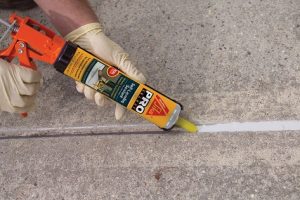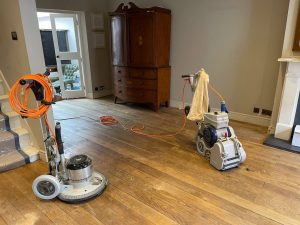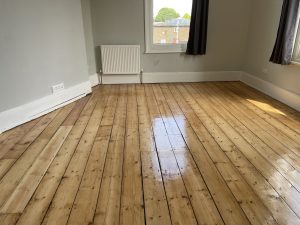The Role of Sealing in the Floor Sanding Process

Enhancing the Durability and Appearance of Your London Home’s Wooden Floors
Introduction
Sealing is a crucial step in the floor sanding process that ensures the longevity, durability, and beauty of your wooden floors. This process involves applying a protective layer that safeguards the wood from damage and wear. In this guide, we’ll explore the role of sealing in floor sanding and how it benefits your London home.
Why Sealing is Important
Sealing your wooden floors after sanding is essential for several reasons:
- Protection: Sealing provides a protective barrier against moisture, stains, and scratches, which can damage the wood over time.
- Durability: A properly sealed floor is more durable and can withstand daily wear and tear, extending the lifespan of your floors.
- Enhanced Appearance: Sealing enhances the natural beauty of the wood, bringing out its grain and colour, and giving it a polished, finished look.
The Sealing Process
The sealing process involves several key steps to ensure your floors are properly protected and look their best:
- Preparation: Before sealing, the floors must be thoroughly cleaned and free of dust and debris. This ensures that the sealant adheres properly to the wood.
- Choosing the Right Sealant: There are various types of sealants available, including water-based, oil-based, and polyurethane sealants. Each type has its benefits, so it’s important to choose the one that best suits your needs and the type of wood you have.
- Application: The sealant is applied evenly across the floor using a brush, roller, or applicator pad. It’s important to follow the manufacturer’s instructions for application to achieve the best results.
- Drying and Curing: After application, the sealant needs time to dry and cure. This can take anywhere from a few hours to several days, depending on the type of sealant used. Avoid walking on the floor during this time to ensure a smooth, even finish.
Types of Sealants

Understanding the different types of sealants can help you choose the best one for your floors:
- Water-Based Sealants: These are eco-friendly, dry quickly, and provide a clear finish that enhances the wood’s natural colour. They are ideal for homes with children and pets due to their low VOC content.
- Oil-Based Sealants: These sealants penetrate deep into the wood, providing excellent durability and a rich, warm finish. They take longer to dry and have a higher VOC content but are known for their long-lasting protection.
- Polyurethane Sealants: Available in both water-based and oil-based forms, polyurethane sealants offer robust protection against scratches and moisture. They are highly durable and are available in different sheens, from matte to high-gloss.
Maintenance of Sealed Floors
Maintaining sealed floors is essential to keep them looking their best and ensure their longevity:
- Regular Cleaning: Sweep or vacuum regularly to remove dirt and debris that can scratch the surface. Use a damp mop with a mild cleaner designed for sealed wood floors.
- Avoid Harsh Chemicals: Avoid using harsh chemicals or abrasive cleaners that can damage the sealant. Stick to products recommended for sealed wooden floors.
- Protective Measures: Use furniture pads to prevent scratches and place doormats at entrances to reduce dirt and moisture on the floors.
- Periodic Re-Sealing: Depending on the type of sealant and the amount of foot traffic, your floors may need to be re-sealed every few years to maintain their protective barrier.







The Best Lighting Options to Highlight Sanded Floors
The Best Lighting Options to Highlight Sanded Floors Enhance the beauty of your wooden[Read more...]
Cork Tile Sanding
Cork is an environmentally friendly, green resource for flooring, easy to maintain, provides thermal and[Read more...]
Gallery 07 – Pine floor board
[Read more...]
The Importance of Grain Direction in Floor Sanding
The Importance of Grain Direction in Floor Sanding When it comes to floor sanding,[Read more...]
The Benefits of Professional Floor Sanding for Offices
The Benefits of Professional Floor Sanding for Offices Maintaining the floors in your office[Read more...]
Cost Guide: How Much Does Floor Sanding in London Cost?
If you’re looking to rejuvenate your wooden floors and enhance the beauty of your home,[Read more...]
How to Plan a Floor Sanding Project for Multi-Story Homes
How to Plan a Floor Sanding Project for Multi-Story Homes Planning a floor sanding project[Read more...]
Floor sanding and renovation and installation services in Bexley
Bexley: A Historic and Green London Borough Bexley is a charming borough located in the[Read more...]
How to Deal with Pet Damage on Wooden Floors
How to Deal with Pet Damage on Wooden Floors Effective solutions for maintaining beautiful[Read more...]
How to Incorporate Floor Sanding into Your DIY Projects
How to Incorporate Floor Sanding into Your DIY Projects For London homeowners looking to[Read more...]